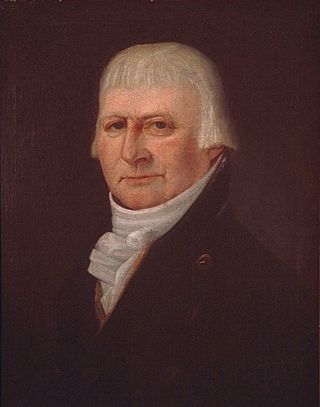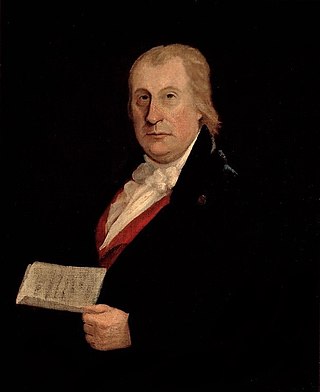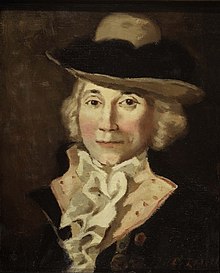
Alexander Henry 'The Elder', in French: Alexandre Henri Le Vieux was an American-born explorer, author, merchant who settled in Quebec following the Conquest of New France and was a partner in the North West Company and a founding member and vice-chairman of the Beaver Club. From 1763 to 1764, he lived and hunted with Wawatam of the Ojibwe, who had adopted him as a brother.

The North West Company was a fur trading business headquartered in Montreal from 1779 to 1821. It competed with increasing success against the Hudson's Bay Company in the regions that later became Western Canada and Northwestern Ontario. With great wealth at stake, tensions between the companies increased to the point where several minor armed skirmishes broke out, and the two companies were forced by the British government to merge.

Simon McTavish, of Montreal was a Scottish-born fur trader and the chief founding partner of the North West Company. He was a member of the Beaver Club and was known as the Marquis for his pre-eminent position in the fur trade and his refined style of living.

Gabriel Christie was a British Army General from Scotland, who settled in Montreal after the Seven Years' War. Following the British Conquest of New France, he invested in land and became one of the largest landowners in the British Province of Quebec.
John Askin (1739–1815) was an Anglo-Irish fur trader, merchant, and colonial official. He was instrumental in the establishment of British rule in Upper Canada.

James McGill was a Scottish-Canadian businessman, fur trader, land speculator, and philanthropist best known for being the founder of McGill University in Montreal. He was elected to the Legislative Assembly of Lower Canada for Montreal West and appointed to the Executive Council of Lower Canada in 1792. He was the honorary Lieutenant-Colonel of the 1st Battalion, Montreal Militia, a predecessor unit of The Canadian Grenadier Guards. He was also a prominent member of the Château Clique and one of the original founding members of the Beaver Club. His summer home stood within the Golden Square Mile.

The Hon. Joseph Frobisher M.P., J.P., was one of Montreal's most important fur traders. He was elected to the 1st Parliament of Lower Canada and was a seigneur with estates totalling 57,000 acres. He was a founding member of the North West Company and the Beaver Club, of which he was chairman. From 1792, his country seat, Beaver Hall, became a centre of Montreal society.
Joseph Bailly was a fur trader and a member of an important French Canadian family that included his uncle, Charles-François Bailly de Messein.

Lt.-Colonel The Hon. William McGillivray, of Chateau St. Antoine, Montreal, was a Scottish-born fur trader who succeeded his uncle Simon McTavish as the last chief partner of the North West Company until a merger between the NWC and her chief rival - the Hudson Bay Company. He was elected a member of the Legislative Assembly of Lower Canada and afterwards was appointed to the Legislative Council of Lower Canada. In 1795, he was inducted as a member into the Beaver Club. During the War of 1812 he was given the rank of lieutenant colonel in the Corps of Canadian Voyageurs as he was the highest up in the NWC's business hierarchy; the ranks of the Corps reflected one's position within the NWC as the Company had created the Corps under their own volition, and using employees as soldiers. He owned substantial estates in Scotland, Lower and Upper Canada. His home in Montreal was one of the early estates of the Golden Square Mile. McGillivray Ridge in British Columbia is named for him, as well as a handful of elementary schools in Ontario, Quebec, or British Columbia.
The XY Company, also known as the New North West Company, was a joint-stock fur trading enterprise based in Montreal that conducted business chiefly in the Canadian Northwest between 1798 and 1804. It was established in opposition to the North West Company, whose employees called it the Little Company and the Potties.

The Pays d'en Haut was a territory of New France covering the regions of North America located west of Montreal. The vast territory included most of the Great Lakes region, expanding west and south over time into the North American continent as the French had explored. The Pays d'en Haut was established in 1610 and depended on the colony of Canada until 1763, when the Treaty of Paris ended New France, and both were ceded to the British as the Province of Quebec.
L'Arbre Croche, known by the Odawa people as Waganagisi, was a large Odawa settlement in Northern Michigan. The French called it L'Arbre Croche for the large crooked tree that marked the center of the settlement and was visible for many miles. It covered the region from Harbor Springs to Cross Village in present-day Emmet County, Michigan.
John Strettell (1721–1786) of London, England, was one of the most important merchants providing trade goods to the Canadian fur trade in the period between the Conquest of Canada and his death in 1786.

Isaac Todd was one of Montreal's most prominent merchants following the British Conquest of New France and a founding member of the Beaver Club at Montreal and the Canada Club at London. He was one of the earliest partners in the North West Company before it was formalized, but was better known for his partnership with James McGill. In 1812, he purchased Buncrana Castle in Inishowen, County Donegal, which he left to his nephew, William Thornton-Todd, the younger brother of Andrew Todd.

The Beaver Club was a gentleman's dining club founded in 1785 by the predominantly English-speaking men who had gained control of the fur trade of Montreal. According to the club's rules, the object of their meeting was "to bring together, at stated periods during the winter season, a set of men highly respectable in society, who had passed their best days in a savage country and had encountered the difficulties and dangers incident to a pursuit of the fur trade of Canada". Only fragmentary records remain of their meetings, but from these it is clear that the Beaver Club was "an animated expression of the esprit de corps of the North West Company". The men of the Beaver Club were the predecessors of Montreal's Square Milers.
Pedlar is a term used in Canadian history to refer to English-speaking independent fur traders from Montreal who competed with the Hudson's Bay Company in western Canada from about 1770 to 1803. After 1779 they were mostly absorbed by the North West Company. The name was first used by the Hudson's Bay Company to refer to French coureurs des bois, who travelled inland to trade with the Indians in their villages and camps. This was in contrast to the HBC policy of building posts on Hudson Bay, to where the Indians would bring furs to trade with them.

Lt.-Colonel The Hon. Roderick Mackenzie of Terrebonne was a Canadian fur trader, landowner and politician. He was a partner in the North West Company and a member of the Beaver Club at Montreal. He was a lifelong friend and the private confidant of his first cousin, Sir Alexander Mackenzie. He was an intellectual who established a library at Fort Chipewyan and both wrote and published works on the fur trade. In 1801 he made his home at Terrebonne, Quebec, purchasing the Seigneury in 1814, although he was forced by a court action to relinquish his title to the property in 1824. He continued to live there until his death. He held many public appointments, most notably as a member of the Legislative Council of Lower Canada.

Colonel Daniel Robertson was an officer in the British Army in North America, commandant of the British post at Michilimackinac, and a landowner in Chatham Township, Canada. Born in Scotland, he first joined the 42nd Regiment of Foot, also known as the "Black Watch," and was present at the British capture of Montreal in 1760, as well as the invasion of Martinique in 1762. During the American Revolutionary War, he was an officer in the 84th Regiment of Foot, another regiment of Scots known as the Royal Highland Emigrants. In 1779, he was appointed commandant of Fort Osgewatchie and oversaw Native American raids on American settlements on the Mohawk River.
Monette, also known as Manette, was a Native American woman enslaved by John Askin. She gave birth to three educated children and married into prominent families of the Great Lakes regions of present-day Michigan and Ontario, Canada. Her son was John Askin Jr. Her daughter Catherine married Captain Samuel Robertson, who operated one of Askin's boats, and was married a second time to Robert Hamilton, founder of Queenston, Ontario. Her daughter Madeline was married to Dr. Robert Richardson, the surgeon of the Queen's Rangers stationed at Fort George.
Madam La Compt is a legendary figure in the Pioneer History of Illinois written by John Reynolds (1788–1865). The book tells the stories of the early settlers of Illinois, based on Reynolds' own memories. Reynolds claims to have known La Compt for 30 years, but his La Compt is semi-fictional, a composite of the lives of three women — a daughter, mother, and grandmother — one of whom was "Mme. Le Comte".











